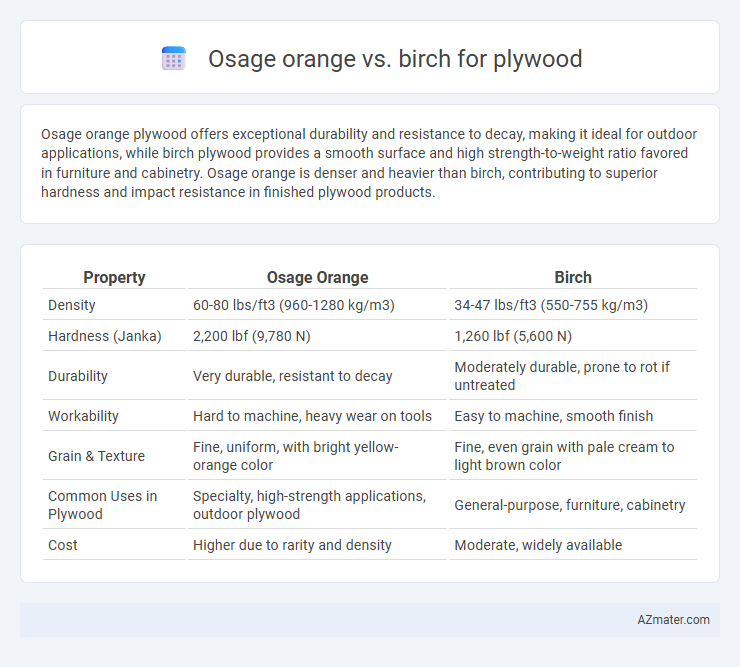Osage orange plywood offers exceptional durability and resistance to decay, making it ideal for outdoor applications, while birch plywood provides a smooth surface and high strength-to-weight ratio favored in furniture and cabinetry. Osage orange is denser and heavier than birch, contributing to superior hardness and impact resistance in finished plywood products.
Table of Comparison
| Property | Osage Orange | Birch |
|---|---|---|
| Density | 60-80 lbs/ft3 (960-1280 kg/m3) | 34-47 lbs/ft3 (550-755 kg/m3) |
| Hardness (Janka) | 2,200 lbf (9,780 N) | 1,260 lbf (5,600 N) |
| Durability | Very durable, resistant to decay | Moderately durable, prone to rot if untreated |
| Workability | Hard to machine, heavy wear on tools | Easy to machine, smooth finish |
| Grain & Texture | Fine, uniform, with bright yellow-orange color | Fine, even grain with pale cream to light brown color |
| Common Uses in Plywood | Specialty, high-strength applications, outdoor plywood | General-purpose, furniture, cabinetry |
| Cost | Higher due to rarity and density | Moderate, widely available |
Introduction to Osage Orange and Birch in Plywood Production
Osage orange and birch are prominent wood species used in plywood production, each offering distinct properties tailored to different applications. Osage orange plywood is valued for its exceptional density, durability, and natural resistance to decay, making it ideal for heavy-duty and outdoor uses. Birch plywood is prized for its fine grain, smooth finish, and high strength-to-weight ratio, commonly utilized in furniture, cabinetry, and interior paneling where aesthetic appeal and structural integrity are critical.
Botanical Characteristics: Osage Orange vs Birch
Osage orange (Maclura pomifera) features a dense, durable hardwood with a distinct yellow-orange hue and a rough, fissured bark, making it highly resistant to decay and pests. Birch (Betula spp.) exhibits a fine, uniform grain with a lighter, creamy-white color and smooth bark often marked by horizontal lenticels, prized for its workability and smooth finish. Both species differ botanically as Osage orange is a mulberry family tree with thorny branches and large, bumpy fruit, while birch belongs to the Betulaceae family, known for its slender leaves and catkins.
Wood Hardness and Durability Comparison
Osage orange wood exhibits a Janka hardness rating of approximately 2,300 lbf, significantly higher than birch's average rating of about 1,260 lbf, indicating superior resistance to wear and denting. In terms of durability, Osage orange's natural rot resistance and dense grain structure enhance its longevity in plywood applications, while birch, though moderately durable, is more susceptible to moisture-induced deterioration. Consequently, Osage orange plywood offers enhanced hardness and extended service life, making it ideal for high-stress or outdoor uses compared to birch plywood.
Workability and Machining Differences
Osage orange plywood offers superior durability and resistance to wear, but it is denser and harder to machine compared to birch plywood, which is renowned for its excellent workability and smooth surface finish. Birch plywood machines cleanly with less tool wear, making it ideal for intricate cuts and detailed woodworking projects, whereas Osage orange requires sharper tools and slower feed rates due to its fibrous, tough grain. The choice between Osage orange and birch for plywood depends heavily on balancing the need for robustness against ease of machining and finishing quality.
Appearance and Grain Patterns
Osage orange plywood displays a distinctive, vibrant yellow to deep orange hue with a fine, interlocking grain pattern that creates a striking, almost textured surface ideal for decorative uses. Birch plywood features a pale, creamy color with a uniform, tight grain pattern that offers a smooth, clean appearance favored in modern cabinetry and furniture-making. While Osage orange stands out for its bold visual impact, birch provides a consistently subtle and refined aesthetic.
Moisture Resistance and Stability
Osage orange plywood exhibits superior moisture resistance due to its dense, naturally rot-resistant fibers, making it ideal for humid or exterior applications. Birch plywood, while offering excellent dimensional stability and smooth surface finish, tends to absorb more moisture, potentially leading to warping or swelling over time. Choosing Osage orange plywood ensures enhanced durability in wet conditions, whereas birch plywood is better suited for interior uses where moisture exposure is limited.
Environmental Impact and Sustainability
Osage orange plywood offers exceptional durability and natural resistance to decay, reducing the need for chemical treatments and enhancing environmental sustainability. Birch plywood, widely used in construction, is favored for its strength and uniform grain but often involves intensive logging practices impacting forest ecosystems. Choosing Osage orange plywood supports sustainable harvesting due to the tree's rapid growth and adaptability, whereas birch's slower regeneration rates may contribute to deforestation concerns.
Cost and Availability of Osage Orange vs Birch
Osage orange plywood is significantly more expensive than birch due to its rarity and slower growth rate, making it less common in the market. Birch plywood is widely available and cost-effective, favored for consistent quality and easy sourcing from abundant birch forests. The high cost and limited availability of Osage orange plywood restrict its use mainly to specialty projects requiring unique durability or aesthetics.
Common Applications in Plywood Manufacturing
Osage orange is rarely used in plywood manufacturing due to its dense, hard nature and irregular grain, which makes it difficult to process and glue effectively. Birch is a highly preferred species for plywood production because of its fine, uniform grain and excellent strength-to-weight ratio, enabling smooth layers and reliable bonding in multi-layered plywood sheets. Common applications of birch plywood include furniture making, cabinetry, and flooring, where durability and aesthetic appeal are critical.
Final Recommendations: Choosing Between Osage Orange and Birch
Osage orange plywood offers superior durability and natural resistance to decay, making it ideal for outdoor or heavy-duty applications, while birch plywood excels in smoothness and uniform grain, perfect for interior furniture and cabinetry. Birch plywood's stability and ease of finishing provide a cost-effective, aesthetically pleasing option for projects requiring fine detail. Choose Osage orange for strength and longevity; select birch for refinement and affordability in plywood construction.

Infographic: Osage orange vs Birch for Plywood
 azmater.com
azmater.com